គោលដៅអភិវឌ្ឍប្រកបដោយចីរភាពទី៣ (គ.អ.ច ៣) សំដៅ “ធានាឱ្យជីវភាពរស់នៅរបស់ប្រជាជនប្រកបដោយសុខភាពល្អ និងលើកកម្ពស់សុខុមាលភាពរបស់មនុស្សគ្រប់រូប និងគ្រប់វ័យ”។1 គោលដៅនេះផ្តោតលើទិដ្ឋភាពយ៉ាងទូលំទូលាយ រួមមានអត្រាមរណភាព ចំនួននៃការឆ្លងជំងឺជាច្រើន ការប្រើប្រាស់ថ្នាំជក់ អត្រានៃការធ្វើអត្តឃាត ការស្លាប់តាមដងផ្លូវ និងការទទួលបានសេវាសុខភាពចាំបាច់ និងផែនការគ្រួសារ។ គោលដៅទី៣ នេះ មានចំណុចដៅចំនួន ៩ មធ្យោបាយនៃការអនុវត្តចំណុចដៅចំនួន ៣ និងសូចនាករចំនួន ២៦។
 | 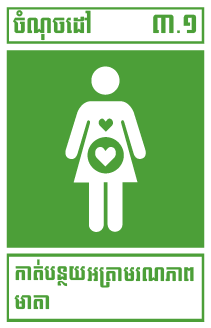 | 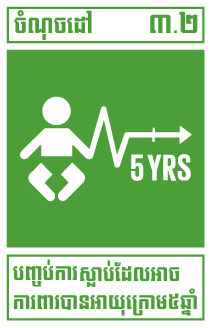 |  | 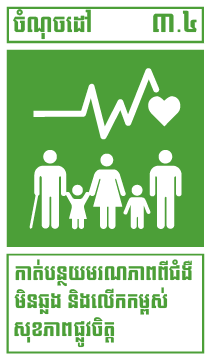 |
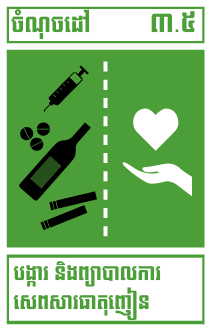 |  | 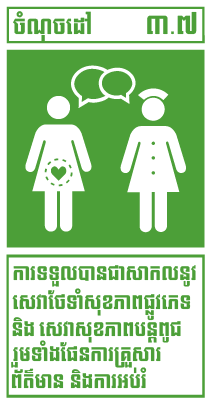 |  | 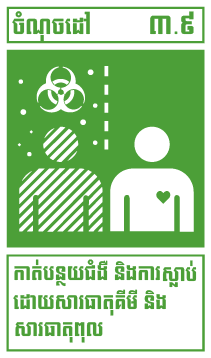 |
 |  |  |  |
ការផ្លាស់ប្តូរពីគោលដៅអភិវឌ្ឍន៍សហស្សវត្សរ៍ ទៅកាន់គោលដៅអភិវឌ្ឍប្រកបដោយចីរភាពទី៣ នៅក្នុងប្រទេសកម្ពុជា
គោលដៅអភិវឌ្ឍប្រកបដោយចីរភាពនេះ កើតចេញពីគោលដៅអភិវឌ្ឍន៍សហស្សវត្សរ៍កម្ពុជា រួមមានគោលដៅទី៤៖ កាត់បន្ថយអត្រាមរណភាពកុមារ គោលដៅទី៥៖ លើកកម្ពស់សុខភាពមាតា និងគោលដៅទី៦៖ ការប្រយុទ្ធប្រឆាំងមេរោគអេដស៍ ជំងឺអេដស៍ ជំងឺគ្រុនចាញ់ និងជំងឺផ្សេងៗទៀត។ ក្នុងចំណោមគោលដៅទាំងអស់នេះ ការកាត់បន្ថយអត្រាមរណភាពរបស់ទារក កុមារអាយុក្រោម៥ឆ្នាំ និងអត្រាមរណភាពមាតាត្រូវបានសម្រេចយ៉ាងពេញលេញ ដូចគ្នានឹងការកាត់បន្ថយអត្រាមរណភាពនៃជំងឺគ្រុនចាញ់ដែរ។ គោលដៅដែលមិនបានសម្រេច រួមមានការកាត់បន្ថយប្រេវ៉ាឡង់ជំងឺអេដស៍ ក្នុងចំណោមប្រជាជនទូទៅ និងការកាត់បន្ថយអត្រាស្លាប់ដោយជំងឺរបេង និងប្រេវ៉ាឡង់ជំងឺរបេង។2
ដូចដែលបានវាយតម្លៃនៅក្នុងការត្រួតពិនិត្យថ្នាក់ជាតិដោយស្ម័គ្រចិត្តឆ្នាំ២០១៩ ការពង្រីក និងការគ្របដណ្តប់កាន់តែច្រើននៃមូលដ្ឋានវេជ្ជសាស្ត្របានជួយធ្វើឱ្យប្រសើរឡើងនូវសុខភាពទូទៅ។ ប៉ុន្តែការប្រើប្រាស់គ្រឿងស្រវឹង និងគ្រឿងញៀន ភាពអសន្តិសុខ នគរូបនីយកម្ម ការសឹករឹចរឹលនៃបរិស្ថាន និងការប្រែប្រួលអាកាសធាតុ បានបង្កការគំរាមកំហែងដល់សុខភាពរបស់ប្រជាជន និងទាមទារឱ្យមានការឆ្លើយតបពហុ និងអន្តរវិស័យ។
ការធ្វើមូលដ្ឋានីយកម្មគោលដៅទី៣ នៅក្នុងប្រទេសកម្ពុជា
នៅចុងឆ្នាំ២០១៨ រាជរដ្ឋាភិបាលកម្ពុជាបានអនុម័តលើក្របខ័ណ្ឌគោលដៅអភិវឌ្ឍប្រកបដោយចីរភាពកម្ពុជា (គ.អ.ច.ក) ឆ្នាំ២០១៦-២០៣០។ ឯកសារនេះកំណត់ចំណុចដៅ និងសូចនាករជាក់លាក់ដែលកម្ពុជាបានអនុម័ត។
ក្នុងចំណោមគោលដៅទាំងអស់ គ.អ.ច.ក ៣ គឺជាគោលដៅមួយដែលយកសមាមាត្រនៃចំណុចដៅ និងសូចនាកររបស់ គ.អ.ច ច្រើនជាងគេ។ ក្របខ័ណ្ឌសកលមានចំណុចដៅចំនួន ១៣ និងសូចនាករចំនួន ២៧ ខណៈដែលក្របខ័ណ្ឌសម្រាប់ គ.អ.ច.ក ៣ មានចំណុចដៅចំនួន ១១ និងសូចនាករចំនួន ២១ (សូមមើលតារាងទី ១)។
តារាងទី១៖ ចំណុចដៅ និងសូចនាករនៃ គ.អ.ច.ក ៣
| ចំណុចដៅនៃគ.អ.ច.ក | សូចនាករនៃ គ.អ.ច.ក | ឯកតា | ឆ្នាំគោល(២០១៥) | ២០២០ | ២០២៥ | ២០៣០ | រយៈពេលត្រួតពិនិត្យ |
| ៣.១ កម្រិតនៃការអភិវឌ្ឍនៃប្រទេសកម្ពុជា៖ សុខភាព និងសុខុមាលភាពរបស់ប្រជាពលរដ្ឋ និងបង្ការហានិភ័យហិរញ្ញវត្ថុ | ៣.១.១ អាយុសង្ឃឹមរស់ពីកំណើត | ៥ឆ្នាំ | |||||
| បុរស | ឆ្នាំ | ៦៧,៥ | ៦៨,១ | ||||
| ស្ត្រី | ឆ្នាំ | ៧១,៤ | ៧១,៩ | ||||
| ៣.១.២ អត្រាលទ្ធភាពបង្កើតកូនសរុប (ចំនួនកូនកើតក្នុងស្ត្រីម្នាក់) | ចំនួនកូនកើតក្នុងស្ត្រីម្នាក់ | ២,៧ (២០១៤) | ២,១ | ៥ឆ្នាំ | |||
| ៣.២ ត្រឹមឆ្នាំ២០៣០ កាត់បន្ថយអត្រាមរណៈភាពមាតានៅកម្រិតសាកល ឱ្យនៅកម្រិតទាបជាង ៧០ ក្នុងចំណោម ១០០ ០០០ កំណើតរស់ | ៣.២.១ អត្រាមរណភាពមាតា | ក្នុង ១០០ ០០០ កំណើតរស់ | ១៧០ (២០១៤) | ១៣០ | ១០០ | ៧០ | ៥ឆ្នាំ |
| ៣.២.២ ភាគរយនៃការសម្រាលដោយបុគ្គលិកសុខាភិបាលមានជំនាញ | % | ៨៩,០ | ៩០,០ | ៩៣,០ | ៩៥,០ | ១ឆ្នាំ | |
| ៣.៣ ត្រឹមឆ្នាំ២០៣០ បញ្ចប់ការស្លាប់ដែលអាចការពារបាននៃទារកទើបកើត និងកុមារអាយុក្រោម៥ឆ្នាំ ដោយគ្រប់ប្រទេសទាំងអស់ មានគោលដៅកាត់បន្ថយមរណភាពទារកទើបកើតដល់ត្រឹម១២ ក្នុង១០០០កំណើតរស់ និងមរណភាពកុមារក្រោមអាយុ៥ឆ្នាំ យ៉ាងហោចណាស់ដល់ត្រឹម២៥ឆ្នាំក្នុងចំណោម ១០០០ កំណើតរស់ | ៣.៣.១ អត្រាមរណភាពកុមារអាយុក្រោម៥ឆ្នាំ | ក្នុង ១០០០ កំណើតរស់ | ៣៥,០ (២០១៤) | ៣០ | ២៨ | ២៥ | ៥ឆ្នាំ |
| ៣.៣.២ អត្រាមរណភាពទារកទើបកើត (ក្នុង ១០០០ ទារកកើតរស់) | ក្នុង ១០០០ កំណើតរស់ | ១៨,០ (២០១៤) | ១៤ | ១៣ | ១២ | ៥ឆ្នាំ | |
| ៣.៤ បញ្ចប់ការរីករាលដាលមេរោគអេដស៍ ជំងឺរបេង គ្រុនចាញ់ ជំងឺតំបន់ត្រូពិចដែលមិនត្រូវបានយកចិត្តទុកដាក់ និងជំងឺថ្លើម ជំងឺឆ្លងតាមទឹក និងជំងឺឆ្លងផ្សេងទៀត នៅត្រឹមឆ្នាំ២០៣០ | ៣.៤.១ អត្រានៃករណីឆ្លងថ្មីនៃមេរោគអេដស៍ក្នុងចំណោមប្រជាជនដែលគ្មានផ្ទុកមេរោគអេដស៍ ១០០០ នាក់ | ក្នុងប្រជាជន ១០០០ នាក់ | ០,០៥ | ០,០៣ | ០,០២ | ០,០២ | ៣ឆ្នាំ |
| ៣.៤.២ អាំងស៊ីដង់ (ករណីឆ្លងថ្មី) នៃជំងឺរបេង | ក្នុងប្រជាជន ១០០ ពាន់នាក់ | ៣៨០ | ៣១០ | ២៣៦ | ១៧៣ | ៥ឆ្នាំ | |
| ៣.៤.៣ អាំងស៊ីដង់ (ករណីឆ្លងថ្មី) នៃជំងឺគ្រុនចាញ់ | ក្នុងប្រជាជន ១០០០ នាក់ | ២,០០ | ១,០៥ | ០ | ០ | ១ឆ្នាំ | |
| ៣.៥ ត្រឹមឆ្នាំ២០៣០ កាត់បន្ថយឱ្យបានមួយភាគបីនៃមរណភាពមុនអាយុកាលរំពឹងទុកពីជំងឺមិនឆ្លង តាមរយៈការការពារ និងការព្យាបាល និងលើកកម្ពស់សុខភាពផ្លូវចិត្ត និងសុខុមាលភាព | ៣.៥.១ អត្រាស្លាប់ដែលបណ្ដាលមកពីជំងឺបេះដូង សរសៃឈាម មហារីក ទឹកនោមផ្អែម ឬជំងឺផ្លូវដង្ហើមរ៉ាំរ៉ៃក្នុងចំណោមប្រជាជនអាយុពី៣០ ទៅ៧០ឆ្នាំ | % | ៣៦,០ | ៣៤,០ | ៣២,០ | ៣០,០ | ៥ឆ្នាំ |
| ៣.៥.២ ភាគរយនៃប្រជាជនពេញវ័យមានជំងឺធ្លាក់ទឹកចិត្តបានទទួលសេវាព្យាបាល | % | ២,០ | ២០,០ | ៣០,០ | ៥០,០ | ១ឆ្នាំ | |
| ៣.៦ ពង្រឹងការបង្ការ និងការព្យាបាលការសេពសារធាតុរួមទាំងការសេពគ្រឿងញៀន និងការប្រើប្រាស់ជាតិសុរាដែលនាំឱ្យគ្រោះថ្នាក់ | ៣.៦.១ ភាគរយនៃប្រជាជនប្រើប្រាស់គ្រឿងញៀនបានទទួលសេវាព្យាបាល | % | ២២,០ | ៨០,០ | >៨០ | >៨០ | ១ឆ្នាំ |
| ៣.៦.២ ប្រេវ៉ាឡង់នៃការប្រើប្រាស់សារជាតិអាល់កុលក្នុងចំណោមមនុស្សពេញវ័យចាប់ពីអាយុ១៨ឆ្នាំឡើង | ៥៣,៥ (២០១០) | ៤៥,៣ | ៤៤,៩ | ៤៤,៤ | ៥ឆ្នាំ | ||
| ៣.៧ ត្រឹមឆ្នាំ២០២០ កាត់បន្ថយឱ្យបានពាក់កណ្ដាលនៃចំនួនមនុស្សស្លាប់ដោយគ្រោះថ្នាក់ចរាចរណ៍នៅទូទាំងពិភពលោក | ៣.៧.១ អត្រាស្លាប់ដោយគ្រោះថ្នាក់ចរាចរណ៍ផ្លូវគោក | ក្នុងប្រជាជន ១០០ ពាន់នាក់ | ១៤,៧០ | ១២,២៥ | ៩,២១ | ៧,១៣ | ១ឆ្នាំ |
| ៣.៨ ត្រឹមឆ្នាំ២០៣០ ធានាថា ការទទួលបានជាសាកលនូវសេវាថែទាំសុខភាពផ្លូវភេទ និងសេវាសុខភាពបន្តពូជ រួមទាំងផែនការគ្រួសារ ព័ត៌មាន និងការអប់រំ និងការធ្វើសមាហរណកម្មសុខភាពបន្តពូជទៅក្នុងកម្មវិធី និងយុទ្ធសាស្ត្រជាតិ | ៣.៨.១ សមាមាត្រនៃស្ត្រីក្នុងវ័យបន្តពូជ (អាយុ១៥-៤៩ឆ្នាំ) ដែលត្រូវការ និងពេញចិត្តមធ្យោបាយពន្យារកំណើតទំនើប | % | ៥៧,០ | ៦២,០ | ៦៥,០ | ៦៨,០ | ៥ឆ្នាំ |
| ៣.៨.២ ភាគរយនៃស្ត្រីវ័យជំទង់អាយុ១៥-១៩ឆ្នាំដែលមានគភ៌ | % | ១១,៥ | ៨,០ | ៦,០ | ៤,០ | ១ឆ្នាំ | |
| ៣.៩ សម្រេចឱ្យបាននូវសុខភាពល្អជាសកល រួមទាំងការបង្ការហានិភ័យផ្នែកហិរញ្ញវត្ថុ ការទទួលបាននូវសេវាថែទាំសុខភាពចាំបាច់ដែលមានគុណភាព និងការទទួលបានថ្នាំពេទ្យ និងថ្នាំបង្ការចាំបាច់ដែលមានគុណភាព មានប្រសិទ្ធភាព និងសុវត្ថិភាព សម្រាប់ប្រជាជនគ្រប់រូប | ៣.៩.១ %នៃប្រជាជនដែលគ្របដណ្ដប់ដោយប្រព័ន្ធគាំពារសុខភាពសង្គម (មូលនិធិសមធម៌ និងការធានារ៉ាប់រងសុខភាព) | % | ២៣,០ | ៥០,០ | ១ឆ្នាំ | ||
| ៣.៩.២ ចំណាយថវិកាជាតិចរន្តលើសុខភាពគិតជា% នៃផលិតផលសរុបក្នុងស្រុក | % | ១,២៤ | ២,០ | ១ឆ្នាំ | |||
| ៣.a ពង្រឹងការអនុវត្តក្របខ័ណ្ឌអនុសញ្ញារបស់អង្គការសុខភាពពិភពលោក ស្ដីពីការត្រួតពិនិត្យថ្នាំជក់ឱ្យបានហ្មត់ចត់នៅក្នុងគ្រប់ប្រទេស | ៣.a.១ ប្រេវ៉ាឡង់នៃការប្រើប្រាស់ថ្នាំជក់ក្នុងចំណោមប្រជាជន អាយុ១៥ឆ្នាំឡើង | ៥ឆ្នាំ | |||||
| ប្រុស | % | ៤០,០ | ៣៤,៦ | ៣០,០ | ២៧,០ | ||
| ស្រី | % | ១៥,០ | ១៣,៧ | ១០,០ | ៨,០ | ||
| ៣.a.២ ប្រេវ៉ាឡង់នៃការប្រើប្រាស់ថ្នាំជក់ក្នុងចំណោមយុវវ័យអាយុពី១៣-១៥ឆ្នាំ | % | ៦,៣ | ៥,០ | ១០,០ | ៨,០ | ៥ឆ្នាំ | |
| ៣.c បង្កើនជាបន្តបន្ទាប់ការវិភាជថវិកាលើវិស័យសុខាភិបាល និងជ្រើសរើសការអភិវឌ្ឍការបណ្ដុះបណ្ដាល និងការជួលបុគ្គលិកផ្នែកសុខាភិបាលនៅក្នុងប្រទេសកម្ពុជា | ៣.c.១ ផលធៀបវេជ្ជបណ្ឌិត/គិលានុប្បដ្ឋាក/យិកា/ឆ្មប លើប្រជាជន ១ ០០០នាក់ | ក្នុងប្រជាជន ១០០០ នាក់ | ១,៥ | ២,០ | ២,២ | ២,៤ | ១ឆ្នាំ |
អត្រាមរណភាពទារក និងកុមារអាយុក្រោម ៥ឆ្នាំ
សម្រាប់ប្រទេសដែលមានប្រាក់ចំណូលទាបដូចជាប្រទេសកម្ពុជា ការខ្វះខាតទ្រព្យសម្បត្តិមិនមែនជាឧបសគ្គរារាំងដល់ការជួយសង្គ្រោះអាយុជីវិតកុមារឡើយ។ នេះ អាចត្រូវបានគេមើលឃើញដោយអត្រាប្រចាំឆ្នាំនៃការកាត់បន្ថយអត្រាមរណភាពកុមារអាយុក្រោម ៥ឆ្នាំ ចាប់តាំងពីឆ្នាំ១៩៩៥ មក។ បណ្តាប្រទេសនៃកម្រិតប្រាក់ចំណូលទាំងអស់ លើកលែងតែប្រទេសដែលមានប្រាក់ចំណូលខ្ពស់ បានឆ្លងកាត់ការធ្លាក់ចុះយ៉ាងឆាប់រហ័សចំពោះអត្រាប្រចាំឆ្នាំនៃអត្រាមរណភាពកុមារអាយុក្រោម ៥ ឆ្នាំ រួមមានប្រទេសកម្ពុជា ជាដើម។3 ទោះបីជាយ៉ាងណាក៏ដោយ អត្រាមរណភាពទារក និងមាតា និងកុមារអាយុក្រោម ៥ ឆ្នាំ និងប្រេវ៉ាឡង់នៃកង្វះអាហារូបត្ថម្ភនៅមានកម្រិតខ្ពស់នៅឡើយ បើប្រៀបធៀបនឹងប្រទេសដទៃទៀតនៅក្នុងតំបន់។
ប្រទេសកម្ពុជា បានលើកកម្ពស់របៀបវារៈសុខភាពរបស់ខ្លួន តាមរយៈហេដ្ឋារចនាសម្ព័ន្ធសុខភាពដែលកំពុងរីកចម្រើន កំណើនសេដ្ឋកិច្ច និងការកាត់បន្ថយភាពក្រីក្រ ដែលនាំឱ្យស្ថានភាពរស់នៅមានភាពប្រសើរឡើង និងបង្កើនអាយុសង្ឃឹមរស់ពីកំណើត។ ក្នុងរយៈពេល ៥ឆ្នាំ ចាប់ពីឆ្នាំ២០០០ ដល់ ២០០៥ ប្រទេសកម្ពុជាមានការកើនឡើងអាយុសង្ឃឹមរស់ពីកំណើត ចាប់ពី ៦១,៩ ដល់ ៦៨,៧ឆ្នាំ។4 ការកែលម្អសេវាកម្មសម្រាប់ម្តាយ រួមទាំងការថែទាំមុនពេលសម្រាល និងក្រោយពេលសម្រាល ទំនងជាកត្តាជំរុញដ៏សំខាន់សម្រាប់ការសម្រេចបាននូវការកាត់បន្ថយអត្រាមរណភាពទារក និងកុមារអាយុក្រោម ៥ ឆ្នាំ។ ចំនួនមណ្ឌលសុខភាពបានកើនឡើងពី ១១០៥ ក្នុងឆ្នាំ២០១៤ ដល់ ១២០៥ ក្នុងឆ្នាំ២០១៨ និងមន្ទីរពេទ្យពី៩៧ ដល់ ១២៣។5 ការចាក់វ៉ាក់សាំងកុមារ និងចំនួនម្តាយដែលបំបៅកូនដោយទឹកដោះក៏បានកើនឡើងផងដែរ។
អត្រាមរណភាពទារក និងកុមារអាយុក្រោម៥ឆ្នាំ នៅតំបន់មេគង្គ6
អត្រាមរណភាពមាតា
ការធ្វើឱ្យប្រសើរឡើងធាតុចូលវេជ្ជសាស្ត្រសំខាន់ៗនៅទូទាំងប្រទេសកម្ពុជា រួមទាំងតំបន់ដាច់ស្រយាល និងតំបន់ដែលមានការអភិវឌ្ឍសេដ្ឋកិច្ចទាបបានជួយកម្ពុជាសម្រេចបាននូវការកាត់បន្ថយអត្រាមរណភាពមាតា និងទារក។ អត្រាមរណភាពមាតាបានថយចុះពី ៤៧២នាក់ ក្នុងអត្រាកំណើតរស់ ១០០ ០០០នាក់ ក្នុងឆ្នាំ២០០៥ រហូតដល់ ១៧០នាក់ ក្នុងឆ្នាំ២០១៤។ អត្រាមរណភាពទារកបានថយចុះពី ៦៦នាក់ ក្នុងអត្រាកំណើតរស់ ១០០០នាក់ នៅឆ្នាំ២០០៥ មកសល់ត្រឹមតែ ២៨នាក់ នៅឆ្នាំ២០១៤។7 បច្ចុប្បន្ននេះ វត្តមាននៃបុគ្គលិកសុខាភិបាលមានជំនាញសម្រាប់ការសម្រាលកូនបានកើនឡើងដល់ ៨៥ភាគរយ។ និងសម្រាប់ការថែទាំក្រោយពេលសម្រាលបានកើនឡើងដល់ ៩០ភាគរយ។ ចំនួននៃការសម្រាលដោយការវះកាត់ក៏មានការកើនឡើងខ្ពស់ផងដែរ ចាប់តាំងពីការធ្វើឱ្យប្រសើរឡើងនៃវត្តមានរបស់បុគ្គលិកសុខាភិបាលដែលមានជំនាញ។
តាមរយៈវឌ្ឍនភាពទាំងអស់នេះ វាជាការសំខាន់ក្នុងការកត់សម្គាល់ថាចំណុចដៅចម្បងត្រូវបានរៀបចំឡើងដោយតម្លៃមូលដ្ឋានខ្ពស់ ហើយអត្រាមរណភាពមាតានៅតែមានកម្រិតខ្ពស់ បើធៀបនឹងស្តង់ដារអន្តរជាតិ។ សម្រាប់ករណីសុខភាពបន្តពូជ និងការពន្យារកំណើតមានតែ ៣៥ភាគរយ។ ប៉ុណ្ណោះដែលបានប្រើវិធីពន្យារកំណើត ខណៈចំណុចដៅទាមទារឱ្យមាន ៦០ភាគរយ។។ គម្លាតដ៏សំខាន់នេះ ត្រូវបានអមដោយអត្រាខ្ពស់នៃការមានផ្ទៃពោះក្នុងវ័យជំទង់។ តាមរយៈការពង្រីកសេវាកម្ម និងការអប់រំជាបន្តបន្ទាប់ ការពន្យារកំណើតអាចរីកសុះសាយ ហើយការមានផ្ទៃពោះក្នុងវ័យជំទង់អាចកាត់បន្ថយបាន។8
មេរោគអេដស៍/ជំងឺអេដស៍ និងជំងឺឆ្លង
ខណៈពេលដែលប្រទេសកម្ពុជាសម្រេចបានជោគជ័យនូវចំណុចដៅពាក់ព័ន្ធជំងឺគ្រុនចាញ់នៅក្នុងគោលដៅអភិវឌ្ឍន៍សហស្សវត្សរ៍មុនៗ តែកម្ពុជាមិនបានសម្រេចនូវចំណុចដៅពាក់ព័ន្ធនឹងការកាត់បន្ថយជំងឺរបេង ក៏ដូចជាការរីករាលដាលនៃមេរោគអេដស៍/ជំងឺអេដស៍។ ធាតុចូលនៃគោលនយោបាយមានសារៈសំខាន់ណាស់ក្នុងការកាត់បន្ថយអត្រាមរណភាពដោយជំងឺគ្រុនចាញ់ និងកាត់បន្ថយជំងឺរបេង ដោយអត្រាប្រេវ៉ាឡង់ទាំងពីរត្រូវបានកាត់បន្ថយនៅពេលដែលធ្វើការពង្រីកការអនុវត្តយុទ្ធសាស្ត្រដូតស៍ (DOTS) នៅថ្នាក់មណ្ឌលសុខភាពទាំងអស់ក្នុងឆ្នាំ២០០៤។ ទោះជាយ៉ាងណាក៏ដោយ កង្វះចំណេះដឹងអំពីសុខភាពផ្លូវភេទ និងសុខភាពបន្តពូជរបស់មនុស្សវ័យជំទង់ និងយុវវ័យ និងការកើនឡើងនៃការមានផ្ទៃពោះក្នុងវ័យជំទង់នៅតែជាបញ្ហាប្រឈម។ អត្រាប្រេវ៉ាឡង់នៃអ្នកផ្ទុកមេរោគអេដស៏នៅតែមានកម្រិតខ្ពស់ក្នុងចំណោមក្រុមប្រជាជនសំខាន់ៗដែលប្រឈមនឹងការឆ្លងមេរោគអេដស៍ ដូចជាអ្នកបម្រើសេវាកំសាន្ត បុរសស្រឡាញ់ភេទដូចគ្នា និងបុរសដទៃទៀតដែលរួមភេទជាមួយបុរស ស្ត្រីប្តូរភេទ និងអ្នកប្រើប្រាស់គ្រឿងញៀន ការស្លាប់ដោយសារជំងឺរបេងនៅមានកម្រិតខ្ពស់ ហើយអត្រាខ្ពស់នៃភាពស៊ាំនឹងថ្នាំ ជាពិសេសការព្យាបាលជំងឺរបេង និងគ្រុនចាញ់នៅតែជាបញ្ហាប្រឈមផ្នែកសុខាភិបាល។9
នៅឆ្នាំ២០១៤ UNAIDS ប្តេជ្ញាចិត្តដើម្បីសម្រេចបាននូវទិសដៅ ៩០-៩០-៩០ នៅទូទាំងពិភពលោកត្រឹមឆ្នាំ២០២០។10 ទិសដៅ ៩០-៩០-៩០ មានគោលបំណងធានាថា ៩០ភាគរយនៃអ្នកផ្ទុកមេរោគអេដស៍យល់ដឹងពីស្ថានភាពមេរោគអេដស៍របស់ខ្លួន ហើយ ៩០ភាគរយនៃអ្នកផ្ទុកមេរោគអេដស៍បានទទួលការព្យាបាលដោយឱសថប្រឆាំងនឹងមេរោគអេដស៍ និង ៩០ភាគរយនៃអ្នកកំពុងទទួលការព្យាបាលនឹង មានបន្ទុកមេរោគអេដស៍ក្នុងឈាមទាបបំផុត។ ករណីឆ្លងមេរោគអេដស៍ថ្មីនៅកម្ពុជាបានធ្លាក់ចុះជាលំដាប់ចាប់តាំងពីឆ្នាំ២០១៥មក ដោយសម្រេចបាននូវទិសដៅ ៩០-៩០-៩០ មុនកាលកំណត់ឆ្នាំ២០២០។ ប្រទេសកម្ពុជា និងបណ្ដាប្រទេស៦ ផ្សេងទៀត ដែលបានសម្រចទិសដៅ៩០-៩០-៩០ នេះមុនកាលកំណត់ឆ្នាំ២០២០។ ទិសដៅនេះបានកើនឡើងដល់ ៩៥ ភាគរយសម្រាប់ការធ្វើតេស្តរកមេរោគអេដស៍ ការព្យាបាល និងការមានបន្ទុកមេរោគអេដស៍ក្នុងឈាមទាបបំផុត នៅត្រឹមឆ្នាំ២០៣០។
ភាពខុសគ្នាគួរឱ្យកត់សម្គាល់រវាងជំងឺនីមួយៗនៅតែបន្តមានក្នុងសូចនាករទាំងអស់នៃ គ.អ.ច ៣។ បញ្ហានេះ គឺមួយផ្នែកពាក់ព័ន្ធនឹងហេតុផលតំបន់ភូមិសាស្ត្រ ដូចជាខេត្តដែលដង់ស៊ីតេមូសមានកម្រិតខ្ពស់ មួយផ្នែកពាក់ព័ន្ធនឹងស្ថានភាពសេដ្ឋកិច្ច សង្គមកិច្ច ដូចជាគ្រួសារក្រីក្រមានបញ្ហាប្រឈមតម្រូវការច្រើន និងមានលទ្ធភាពតិចតួចក្នុងការទទួលបានការព្យាបាលដោយខ្លួនឯង។ ភាពខុសគ្នាទាំងនេះដែលបណ្តាលមកពីវិសមភាពប្រាក់ចំណូល និងជីវភាពរស់នៅ បណ្តាលឱ្យមានលទ្ធភាពទទួលបានសេវាថែទាំសុខភាព និងសេវាកម្មសាធារណៈគុណភាពផ្សេងៗគ្នា។ ការកែលម្អ គឺចាំបាច់សម្រាប់បញ្ហាធនធាន និងការបែងចែកធនធាននេះជាសាធារណៈ និងពង្រឹងសេវានៃប្រព័ន្ធសម្ភពនៅមូលដ្ឋាន។ 11
មធ្យោបាយនៃការអនុវត្តគោលដៅអភិវឌ្ឍន៍ប្រកបដោយចីរភាពទី៣ នៅក្នុងប្រទេសកម្ពុជា
គោលដៅអនុវត្តចំនួនពីរ សម្រាប់ការអនុវត្តគោលដៅអភិវឌ្ឍន៍ប្រកបដោយចីរភាពកម្ពុជាទី៣ រួមមាន៖
- ៣.a ពង្រឹងការអនុវត្តក្របខ័ណ្ឌ អនុសញ្ញាស្តីពីការត្រួតពិនិត្យថ្នាំជក់របស់អង្គការសុខភាពពិភពលោក
- ៣.c បង្កើនហិរញ្ញប្បទានសុខាភិបាល និងការជ្រើសរើស ការអភិវឌ្ឍ ការបណ្តុះបណ្តាល និងការរក្សាសុខភាពរបស់ពលកម្ម នៅកម្ពុជា
ផែនការយុទ្ធសាស្ត្រសុខាភិបាល ២០១៦-២០២០ គឺជាឧបករណ៍គ្រប់គ្រងជាយុទ្ធសាស្ត្រ ដែលផ្ដល់មគ្គុទេសភាពដល់ក្រសួងសុខាភិបាល និងអង្គភាពសុខាភិបាលទាំងអស់ ព្រមទាំងដៃគូពាក់ព័ន្ធ។ ផែនការយុទ្ធសាស្ត្រសុខាភិបាល ២០១៦-២០២០ បញ្ជាក់ជាថ្មីពីចក្ខុវិស័យរយៈពេលវែងនៃការអភិវឌ្ឍវិស័យសុខាភិបាល និងដាក់ចេញក្របខ័ណ្ឌយុទ្ធសាស្ត្រសម្រាប់ពង្រឹងប្រតិបត្តិការក្នុងវិស័យសុខាភិបាលទាំងមូល ទាំងផ្នែកសាធារណៈ និងឯកជន ដើម្បីដោះស្រាយបញ្ហាអាទិភាព និងធានាថាយុទ្ធសាស្ត្រវិស័យសុខាភិបាលត្រូវបានយកទៅអនុវត្ត ឱ្យមានសង្គតភាពនៅក្នុងអន្តរាគមន៍នៃកម្មវិធីនានា។ ផែនការយុទ្ធសាស្ត្រក៏បានផ្ដល់ក្របខ័ណ្ឌត្រួតពិនិត្យតាមដានវឌ្ឍនភាព និងវាយតម្លៃលទ្ធផលនៃការអនុវត្ត។ ផែនការនឹងត្រូវបានប្រើប្រាស់ ដើម្បីកៀរគរធនធានហិរញ្ញវត្ថុឱ្យបានគ្រប់គ្រាន់ និងផ្ដល់ព័ត៌មានដល់ការវិភាជន៍សារពើពន្ធព្រមទាំងតម្រង់ទិសជំនួយអភិវឌ្ឍក្នុងវិស័យសុខាភិបាល។12
អង្គការសហប្រជាជាតិបានកត់សម្គាល់នៅក្នុងវេទិកាចំណេះដឹងស្ដីពីគោលដៅអភិវឌ្ឍប្រកបដោយចីរភាពថា សេដ្ឋកិច្ចរបស់ប្រទេសកម្ពុជានៅតែមានកំណើនដោយមានការវិនិយោគច្រើន និងចំណូលសាធារណៈ។ ប៉ុន្តែវាបង្ហាញថាប្រទេសកម្ពុជាមានរបៀបវារៈ គ.អ.ច ប្រកបដោយមហិច្ឆតា និងការកើនឡើងនៃការរំពឹងទុករបស់សាធារណៈជន ស្របពេលការធ្លាក់ចុះជំនួយបរទេស។ ប្រទេសកម្ពុជាមានទាំងឱកាស និងបញ្ហាប្រឈម ជុំវិញការអនុវត្ត គ.អ.ច.ក ៣។
អង្គការសហប្រជាជាតិបានកត់សម្គាល់ថា គម្លាតនៃអភិបាលកិច្ចរបស់ប្រទេសកម្ពុជានៅក្នុងវិស័យនេះទាក់ទងនឹងទិន្នន័យ និងការត្រួតពិនិត្យតាមដាន និងវាយតម្លៃ។ រាជរដ្ឋាភិបាលត្រូវតែឱ្យមានការចូលរួមពីសង្គមស៊ីវិល ប្រជាពលរដ្ឋ និងវិស័យឯកជនក្នុងការអនុវត្ត។
គ.អ.ច ៣ ត្រូវបានយកទៅត្រួតពិនិត្យស៊ីជម្រៅ នៅក្នុងវេទិកានយោបាយជាន់ខ្ពស់ ឆ្នាំ២០១៧។
ប្រធានបទពាក់ព័ន្ធ
ឯកសារយោង
- 1. រាជរដ្ឋាភិបាលកម្ពុជា ឆ្នាំ២០១៨. «ក្របខ័ណ្ឌគោលដៅអភិវឌ្ឍប្រកបដោយចីរភាពកម្ពុជា ឆ្នាំ២០១៦-២០៣០». ចូលអានថ្ងៃទី១៣ ខែសីហា ឆ្នាំ២០១៩.
- 2. ដូចឯកសារយោងខាងលើ.
- 3. អង្គការសហប្រជាជាតិ ឆ្នាំ២០១៥. «របាយការណ៍គោលដៅអភិវឌ្ឍន៍សហស្សវត្សរ៍ឆ្នាំ ២០១៥». ចូលអានថ្ងៃទី២៧ ខែសីហា ឆ្នាំ២០១៩.
- 4. រាជរដ្ឋាភិបាលកម្ពុជា ឆ្នាំ២០១៩. «ការត្រួតពិនិត្យថ្នាក់ជាតិដោយស្ម័គ្រចិត្ត៖ ការអនុវត្តរបៀបវារៈ ឆ្នាំ២០៣០នៃការអភិវឌ្ឍប្រកបដោយចីរភាព». ចូលអានថ្ងៃទី៣០ ខែសីហា ឆ្នាំ២០១៩.
- 5. ដូចឯកសារយោងខាងលើ.
- 6. ក្រុមអន្តរភ្នាក់ងារអង្គការសហប្រជាជាតិ សម្រាប់ការប៉ាន់ប្រមាណលើមរណភាពកុមារ ឆ្នាំ២០១៩. «អត្រាមរណភាពទារក និងកុមារអាយុក្រោម ៥ឆ្នាំ នៅតំបន់មេគង្គ». ចូលអានថ្ងៃទី១២ ខែសីហា ឆ្នាំ២០១៩.
- 7. រាជរដ្ឋាភិបាលកម្ពុជា ឆ្នាំ២០១៩. «ការត្រួតពិនិត្យថ្នាក់ជាតិដោយស្ម័គ្រចិត្ត៖ ការអនុវត្តរបៀបវារៈ ឆ្នាំ២០៣០នៃការអភិវឌ្ឍប្រកបដោយចីរភាព». ចូលអានថ្ងៃទី៣០ ខែសីហា ឆ្នាំ២០១៩.
- 8. រាជរដ្ឋាភិបាលកម្ពុជា ឆ្នាំ២០១៨. «ក្របខ័ណ្ឌគោលដៅអភិវឌ្ឍប្រកបដោយចីរភាពកម្ពុជា ឆ្នាំ២០១៦-២០៣០». ចូលអានថ្ងៃទី១៣ ខែសីហា ឆ្នាំ២០១៩.
- 9. ដូចឯកសារយោងខាងលើ.
- 10. Mothers2mothers. «ទិសដៅ ៩០-៩០-៩០ របស់អង្គការUNAIDS». ចូលអានថ្ងៃទី២៣ ខែសីហា ឆ្នាំ២០១៩.
- 11. រាជរដ្ឋាភិបាលកម្ពុជា ឆ្នាំ២០១៨. «ក្របខ័ណ្ឌគោលដៅអភិវឌ្ឍប្រកបដោយចីរភាពកម្ពុជា ឆ្នាំ២០១៦-២០៣០». ចូលអានថ្ងៃទី១៣ ខែសីហា ឆ្នាំ២០១៩.
- 12. ដូចឯកសារយោងខាងលើ.

